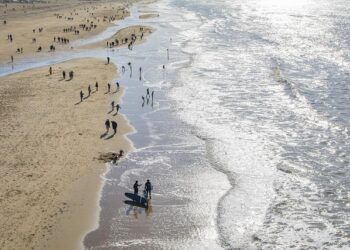Archaeologists have uncovered a remarkably well-preserved Roman military camp dating back approximately 1,800 years in the Netherlands, situated beyond the traditional borders of the Roman Empire. This rare discovery sheds new light on the Empire’s northern frontier operations and challenges existing understandings of Roman military reach and influence in the region. The find, detailed in the latest report by the Indian Defence Review, offers invaluable insights into Roman strategy and presence far from established boundaries, marking a significant milestone in European archaeological research.
Discovery Sheds Light on Roman Military Strategy Beyond Empire Borders
Archaeologists have uncovered an exceptionally well-preserved Roman military camp dating back approximately 1,800 years in the Netherlands, an area far beyond the traditionally accepted limits of the Roman Empire. This rare find provides fresh insights into the empire’s military outreach and strategic foresight during a turbulent era marked by shifting alliances and persistent threats from northern tribes. The camp’s layout, complete with defensive ramparts and internal barracks, reveals how Roman forces adapted their conventional tactics to operate efficiently in unfamiliar and hostile environments.
Detailed analysis of the site has revealed several intriguing features, including:
- Temporary fortifications designed for rapid assembly and disassembly
- Signs of logistical planning for extended supply lines
- Artifacts indicating contact with local populations, suggesting combined military and diplomatic efforts
| Feature | Significance | Estimated Date |
|---|---|---|
| Ramparts & Ditches | Defensive perimeter to deter raids | Circa 220-240 AD |
| Barracks Layout | Indication of troop capacity (~300 soldiers) | Circa 220-240 AD |
| Imported Pottery | Evidence of supply networks | Circa 230 AD |
Insights into Daily Life and Defensive Structures of the Newly Unearthed Camp
Excavations have revealed a detailed glimpse into the daily routines and strategic foresight of the Roman soldiers stationed at this frontier camp. Remnants of wooden barracks arranged in a grid-like pattern suggest a highly organized living quarter, accommodating a garrison likely composed of both infantry and cavalry units. Everyday artifacts such as pottery shards, cooking implements, and personal items like brooches and gaming pieces provide tangible evidence of the soldiers’ attempts to maintain normalcy amidst the uncertainty of a remote mission. The discovery of well-preserved hearths and water drainage systems indicates a focus on sustainability and hygiene, reinforcing how life extended beyond mere military preparedness to encompass domestic comfort.
Defensive structures unearthed at the site demonstrate a layered approach to fortification, combining earthworks with timber palisades and strategically placed watchtowers. Notably, the camp features a triple-ditch system encircling the perimeter, designed to delay and disrupt potential enemy advances. The table below summarizes key defensive features identified:
| Defensive Feature | Material | Function | Estimated Height/Depth |
|---|---|---|---|
| Earthwork Rampart | Compressed soil and clay | Primary barricade | 3.5 meters high |
| Timber Palisade | Wood | Secondary defensive wall | 4 meters high |
| Triple Ditches | Excavated soil | Enemy delay and exposure | Each ~2 meters deep |
| Watchtowers | Wooden frames | Surveillance and signaling | 6 meters tall |
These fortifications reflect a tactical adaptability to the challenges posed by operating beyond the established boundaries of the Roman Empire. The interplay between daily life comforts and robust defense mechanisms underscores the enduring resilience and complexity of Roman military engineering.
Recommendations for Preservation and Future Archaeological Exploration
To ensure the longevity of this remarkable Roman camp site, it is essential to implement a multi-faceted preservation strategy. Authorities should prioritize controlled excavation practices, limiting disturbance to the site while maximizing archeological output. Protective coverings and fencing can safeguard sensitive areas from environmental degradation and unauthorized access. Collaboration with local communities and stakeholders will also foster a sense of stewardship, encouraging grassroots support that aids in monitoring and maintaining the integrity of the site.
Future archaeological exploration must be carefully planned to expand our understanding without compromising the existing findings. Recommendations include:
- Integration of non-invasive technologies such as ground-penetrating radar (GPR) and drone surveying to map subsurface features.
- Periodic reassessment of excavation zones to adapt strategies based on new discoveries.
- Establishment of a digital archive to document artifacts and site data, ensuring accessibility for researchers worldwide.
| Preservation Measure | Purpose | Expected Outcome |
|---|---|---|
| Protective Fencing | Prevent unauthorized access | Site security enhanced |
| Digital Archiving | Comprehensive data documentation | Long-term research facilitation |
| Non-Invasive Surveys | Map hidden structures | Selective excavation guidance |
The Conclusion
The discovery of the 1,800-year-old Roman camp beyond the empire’s traditional borders offers a significant glimpse into Rome’s military reach and strategic presence in the region now known as the Netherlands. As archaeologists continue to study the site, their findings are expected to shed new light on the interactions between Rome and the local populations, as well as the broader dynamics of imperial expansion and frontier defense. This rare unearthing not only enriches our understanding of Roman history but also underscores the enduring value of archaeological exploration in uncovering the complexities of the ancient world.
















